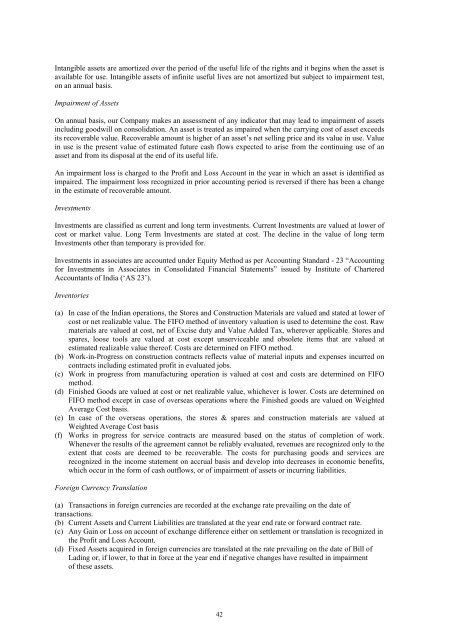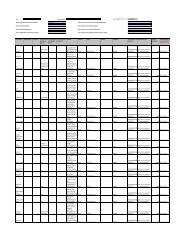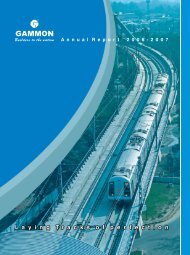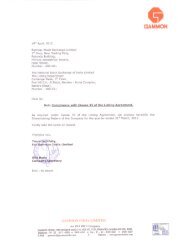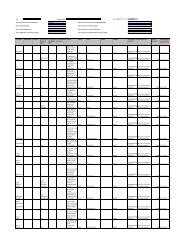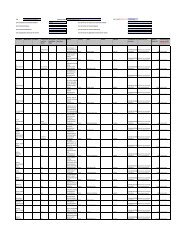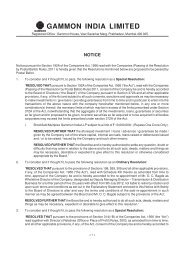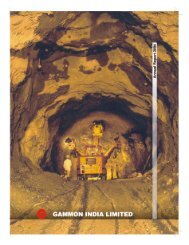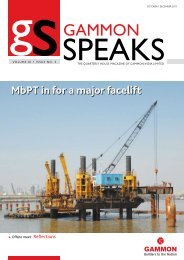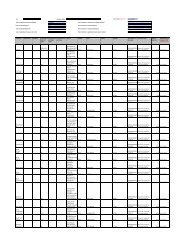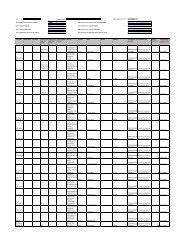GAMMON INDIA LIMITED
GAMMON INDIA LIMITED
GAMMON INDIA LIMITED
You also want an ePaper? Increase the reach of your titles
YUMPU automatically turns print PDFs into web optimized ePapers that Google loves.
Intangible assets are amortized over the period of the useful life of the rights and it begins when the asset is<br />
available for use. Intangible assets of infinite useful lives are not amortized but subject to impairment test,<br />
on an annual basis.<br />
Impairment of Assets<br />
On annual basis, our Company makes an assessment of any indicator that may lead to impairment of assets<br />
including goodwill on consolidation. An asset is treated as impaired when the carrying cost of asset exceeds<br />
its recoverable value. Recoverable amount is higher of an asset’s net selling price and its value in use. Value<br />
in use is the present value of estimated future cash flows expected to arise from the continuing use of an<br />
asset and from its disposal at the end of its useful life.<br />
An impairment loss is charged to the Profit and Loss Account in the year in which an asset is identified as<br />
impaired. The impairment loss recognized in prior accounting period is reversed if there has been a change<br />
in the estimate of recoverable amount.<br />
Investments<br />
Investments are classified as current and long term investments. Current Investments are valued at lower of<br />
cost or market value. Long Term Investments are stated at cost. The decline in the value of long term<br />
Investments other than temporary is provided for.<br />
Investments in associates are accounted under Equity Method as per Accounting Standard - 23 “Accounting<br />
for Investments in Associates in Consolidated Financial Statements” issued by Institute of Chartered<br />
Accountants of India (‘AS 23’).<br />
Inventories<br />
(a) In case of the Indian operations, the Stores and Construction Materials are valued and stated at lower of<br />
cost or net realizable value. The FIFO method of inventory valuation is used to determine the cost. Raw<br />
materials are valued at cost, net of Excise duty and Value Added Tax, wherever applicable. Stores and<br />
spares, loose tools are valued at cost except unserviceable and obsolete items that are valued at<br />
estimated realizable value thereof. Costs are determined on FIFO method.<br />
(b) Work-in-Progress on construction contracts reflects value of material inputs and expenses incurred on<br />
contracts including estimated profit in evaluated jobs.<br />
(c) Work in progress from manufacturing operation is valued at cost and costs are determined on FIFO<br />
method.<br />
(d) Finished Goods are valued at cost or net realizable value, whichever is lower. Costs are determined on<br />
FIFO method except in case of overseas operations where the Finished goods are valued on Weighted<br />
Average Cost basis.<br />
(e) In case of the overseas operations, the stores & spares and construction materials are valued at<br />
Weighted Average Cost basis<br />
(f) Works in progress for service contracts are measured based on the status of completion of work.<br />
Whenever the results of the agreement cannot be reliably evaluated, revenues are recognized only to the<br />
extent that costs are deemed to be recoverable. The costs for purchasing goods and services are<br />
recognized in the income statement on accrual basis and develop into decreases in economic benefits,<br />
which occur in the form of cash outflows, or of impairment of assets or incurring liabilities.<br />
Foreign Currency Translation<br />
(a) Transactions in foreign currencies are recorded at the exchange rate prevailing on the date of<br />
transactions.<br />
(b) Current Assets and Current Liabilities are translated at the year end rate or forward contract rate.<br />
(c) Any Gain or Loss on account of exchange difference either on settlement or translation is recognized in<br />
the Profit and Loss Account.<br />
(d) Fixed Assets acquired in foreign currencies are translated at the rate prevailing on the date of Bill of<br />
Lading or, if lower, to that in force at the year end if negative changes have resulted in impairment<br />
of these assets.<br />
42


